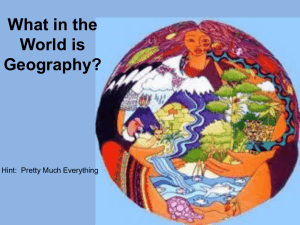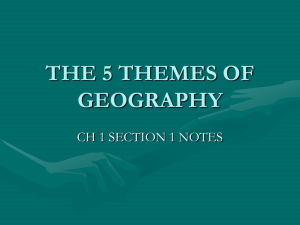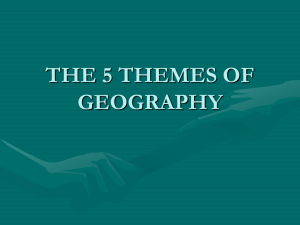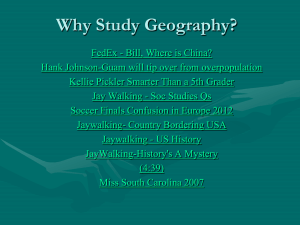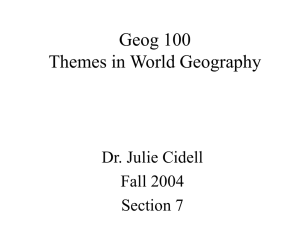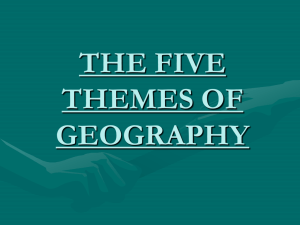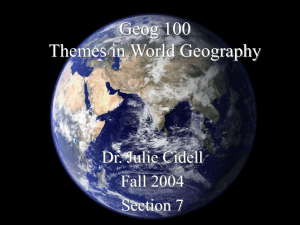Intro to Human Geography / 5 Themes PPT
advertisement
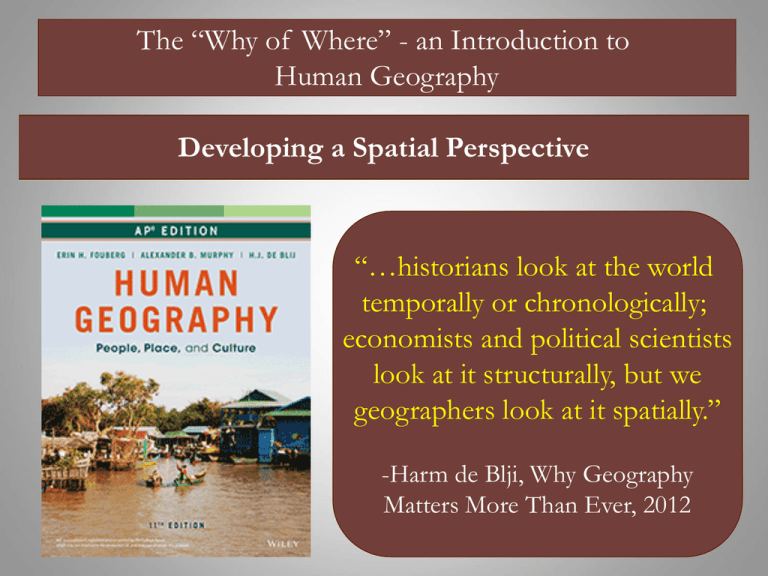
The “Why of Where” - an Introduction to Human Geography Developing a Spatial Perspective “…historians look at the world temporally or chronologically; economists and political scientists look at it structurally, but we geographers look at it spatially.” -Harm de Blji, Why Geography Matters More Than Ever, 2012 Why do you think that there is often such chaos and congestion at self-serve gas stations? Describe • Where is this store located? • What does it tell you about this neigborhood? The Spatial Perspective • Focuses on where something occurs • Key geographic questions: – Where is it? – Why is it there? • Examines how human activities are organized in space and how they relate to the natural environment Developing a Spatial Perspective “Association Among Phenomena in Places….” Or…why things are where they are, and how they relate to other things… • Discussion (Spatial Perspective) 1. Why do you think most pizza places have Chinese take-out places in the same area? 2. Why are certain shopping malls located on bus routes, while others are not? 3. Living in New Jersey, why won’t we see many presidential campaign ads? 4. Why were many Chinese baby girls adopted by American (and typically white) families? Spatial perspective • Whole Foods in New Jersey • Starbucks vs. Dunkin in NJ Yali’s Question • What’s the answer? • How can it be answered from a spatial perspective? Basic Geographic Terms Two Types of Geography Physical Geography: • Where and why natural forces occur as they do – climates, landforms, types of vegetation, etc. • Focus on environmental dynamics Human Geography: • Where and why human activities are located where they are – religions, cities, businesses, governments, etc. • Focus on social dynamics Space – The physical gap or interval between two objects – Spatial distribution • How people, things, and activities are laid out, organized, and arranged on earth Do Now • Our density has been reduced from 29 to 26 (as of today). • What effect does that have on our dispersion/concentration? 3 Main Properties of Spatial Distribution • Density – How often something occurs in a given space • Dispersion / concentration – How spread out something is • Concentrated/clustered = close together • Dispersed/scattered = spread out • Pattern – Design Density-In A we see 6 houses on 1 acre of land. And in B we see 12 houses per acre Concentration-in A we see the houses dispersed and in B we see them clustered. Pattern-in A the houses are in a single linear arrangement, in B the arrangement is irregular. Types of Pattern: (a) Linear Patterns typically depict houses along a street or towns along a railroad (b) Centralized Patterns typically involve items concentrated around a single node. Ex: Center City with surrounding suburbs (c) Random Pattern An unstructured, irregular distribution The changing distribution of North American baseball teams illustrates the difference between density and concentration. The Five Themes of Geography THE FIVE THEMES OF GEOGRAPHY • • • • • Location Place Human-Environment Interaction Movement Regions LOCATION Where is it? • Absolute Location – A latitude and longitude (global location) or a street address (local location). – Paris France is 48o North Latitude and 2o East Longitude. – The White House is located at 1600 Pennsylvania Ave. • Relative Location – Described by landmarks, time, direction or distance. From one place to another. – Go 1 mile west on main street and turn left for 1 block. PLACE What is it like there? • Human Characteristics • Physical • What are the main languages, customs, and beliefs. • How many people live, work, and visit a place. Characteristics • Landforms (mountains, rivers, etc.), climate, vegetation, wildlife, soil, etc. What’s the difference between place and space? • A place is a point • A space is an area – Usually demarcated in some way HUMAN-ENVIRONMENT INTERACTION How do humans and the environment affect each other? – We depend on it • People depend on the Tennessee River for water and transportation – We modify it • People modify our environment by heating and cooling buildings for comfort – We adapt to it • We adapt to the environment by wearing clothing suitable for summer (shorts) and winter (coats), rain and shine MOVEMENT How are people, goods, ideas moved from place to place? – Human Movement • Trucks, Trains, Planes – Information Movement • Phones, computer (email), mail – Idea Movement • How do fads move from place to place? TV, Radio, Magazines MOVEMENT • Spatial interaction = interconnectedness of places • Depends on: – Distance – Accessibility – Connectivity REGIONS What do locations have in common? • A way of subdividing space into categorizable geographic units • 3 types of regions: formal, functional, perceptual Remembering the 5 themes • If you can’t remembering what they are just ask MR. HELP! • M – Movement • R – Regions • HE – Human Environment interaction • L – Location • P - Place Landscape • How physical, human, and symbolic elements come together in a place – Theme of place • Human activity changes natural landscapes into cultural landscapes – Theme of human-environment interaction • Can provide visual cultural history • Reflect identity Philippine Rice Terraces
